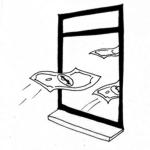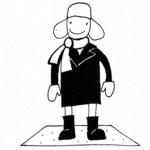Anti Fatigue Floor Mats and Worker Productivity

According to a study posted in the January, 2009 Journal of Occupational and Environmental Medicine, 40% of workers in the U.S. suffer from workplace fatigue and it is costing their companies billions. “Fatigue reduced work performance mainly by interfering with concentration and increasing the time needed to accomplish tasks,” the study said.
While most people can relate to feeling this way at work from time to time, few take the time to consider how costly it is to their employers. “The rate of lost productivity for all health-related reasons was”, “much higher for workers with fatigue: 66 percent, compared with 26 percent for workers without fatigue. Total lost productive time averaged 5.6 hours per week for workers with fatigue, compared to 3.3 hours for their counterparts without fatigue.” |
|

Aside from external factors that contribute to worker fatigue such as depression, anxiety and physical ailments, the workplace itself can present myriad ways to increase fatigue. One example is the flooring. For workers who stand for most of the day, leg and back pain caused by hard floors lead to fatigue and eventually decreased productivity.
What can employers do to relieve such strain on their employees? More and more studies are concluding that anti fatigue matting (also known as cushioned floor mats) significantly cuts down on worker strain thereby increasing their productivity. Take for example restaurant employees. Standing and walking all day on hard tile or concrete floors and trying not to slip and fall takes a huge toll on the legs and back. Kitchen anti fatigue mats provide a cushioned floor mat between the worker and hard floors. These cushioned mats also work wonders by adding traction in wet and greasy areas. |
|

But say employees aren’t working in wet or greasy areas? Ergonomic mats are made for all types of environments! There are anti fatigue mats with solid tops for areas that are not exposed to moisture. Other types of mats have a grit surface to increase traction. One popular choice for dry areas is anti fatigue gel mats. These mats have a tough exterior surrounding a gel center; not unlike the type found in bicycle seats.
What if workers need fatigue mats in especially harsh industrial applications? One example is a ski lift assistant. He stands in pretty much the same spot all day in snow and icy conditions. In order to provide leg and back support in this situation anti fatigue rubber mats are used. Unlike vinyl, PVC or foam, rubber mats remain flexible and lay flat in extreme cold. This is a great asset especially when it comes time to roll them up and transport them. |
|

The decision to invest in an anti fatigue mat for a worker certainly gives managers a bit of concern. What if this money could be better allocated elsewhere in our organization? What if the anti fatigue floor mat doesn’t make any improvement to worker productivity? The good news is that there is a wide price range in this market with something for virtually all budgets.
In this age of technology sometimes the most important component of a workforce is overlooked: the human. Humans have bodies and emotions and moods. Tending to their needs in order to keep workers healthy and happy and not at home sick is the same as applying oil to the gears of a squeaky machine! |
To see all anti-fatigue mats available from MattingExperts.com go
HERE.